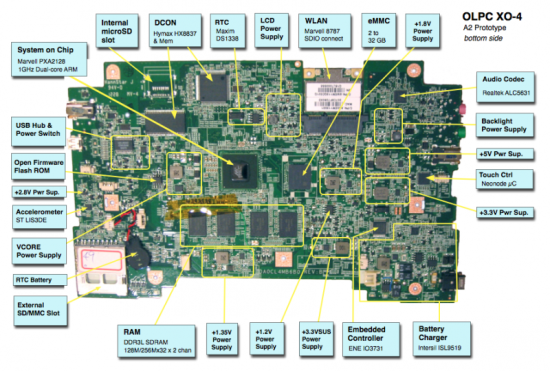Resumen en español al final del artículo

Annotated photo of bottom side of XO-4 A2 version motherboard
In mid-August OLPC formally introduced its upcoming XO-4 Touch which it expects to become available in Q1/2013. Since then we've had a chance to learn a more about the XO-4 models and the hardware which will power them.
The first interesting piece of information came from an e-mail on the IAEP mailing list in which Martin Langhoff (OLPC Association's Senior Software Architect and Technical Director) wrote:
Two variants will be available -- XO-4 Laptop and XO-4 Touch (a laptop with multitouch screen).
Secondly I had a chance to speak to John Watlington (OLPC Association's Vice President of Hardware Engineering) and ask him some questions about the hardware changes between the XO-1.75 and the XO-4 models.
Asked about what features and performance changes we can expect from the move from Marvell's Armada 610 SoC (MMP2) to the PXA2128 SoC (MMP3) he wrote:
Roughly twice the memory bandwidth (two 32b DDR3 memory channels instead of the single 32b channel in the MMP2), over twice the compute power (two cores at 1GHz instead of a single core at 800 MHz, plus improved performance of the core itself), and better graphics performance. (emphasis added)
Color me impressed! In most scenarios the current XO-1.75 is quite a snappy machine but having that performance potentially doubled is quite exciting I dare say.
Another very interesting change is related to the mass storage on the XO-4 models:
The internal microSD card slot is now available in parallel with the internal eMMC (editor's note: an embedded storage solution with a MMC interface). In XO-1.75, you could replace the internal eMMC using the internal microSD card slot, but couldn't use them in parallel.
The original intent in XO-1.75 was to provide a way to repair a motherboard whose eMMC has gone bad. With XO-4, it becomes possible to not just replace but also expand the eMMC as a board ages. eMMC provides a guaranteed reliability which is hard to match with microSD cards, and is available in sizes up to 32 GB (although qualifying a new size takes us around 12 weeks --- we have 4GB and 8GB qualified for XO-1.75 and XO-4). On XO-4, the internal SD socket will not be present (it could be if requested) but one of a couple of common sockets can be added in the field with a simple soldering iron and a #1 screwdriver.
I can already see older children in Uruguay opening their own hardware tuning shops offering this storage upgrade. (And me getting in-line during my next visit to have my own XO tuned.)
As Engadget had previously already reported there is also a new option when it comes to wireless connectivity:
Starting with XO-4, there will be an option for 802.11abgn as well as the 802.11bgn which has shipped with earlier laptops. As this increases the price somewhat, we expect it only to be used in deployments which require 802.11a support.
Last but not least he also confirmed that the XO-4 "will replace one of the USB ports with an HDMI port".
Previously I had been confused about why OLPC decided to make the naming jump from XO-1.75 to XO-4 as the new model seemed to offer little beyond the new touchscreen option. However now with all this new information I'm starting to see how the new model really deserves that number jump. Because overall these changes really make for a significantly more powerful and more versatile XO machine.
Resumen en español: Anteriormente había sido confundido por qué OLPC decidió dar el salto de nombres de XO-1.75 a XO-4 como el nuevo modelo me parecía ofrecer poco más allá de la opción nueva de la pantalla táctil. Sin embargo ahora, con toda esta nueva información en cuanto a rendimiento, conectividad y almacenamiento estoy empezando a ver cómo el nuevo modelo realmente merece este salto númerico. Porque estos cambios realmente hacen una máquina XO significativamente más potente y más versátil.


Has there been any further word whether there is going to be a "commercial partner" who will be offering a version of the XO-4 in the open market? Who might this be? Has a price been established?
Eddie, I'm not sure what commercial partner aspect you're referring to? I've only heard this consideration being mentioned in the context of the XO 3.0 tablet model but not with the XO-4s.
With regard to the price: I don't expect it to be known or publicly discussed until the XO-4 units start being mass-produced in Q1/2013. Also note that OLPC's prices always vary depending on quantity, specific hardware configuration, etc.